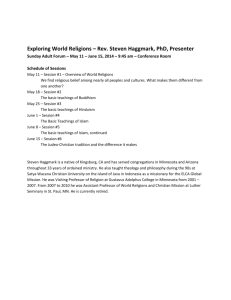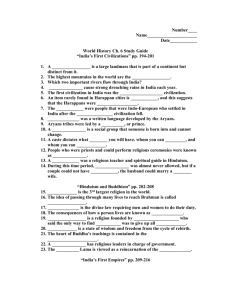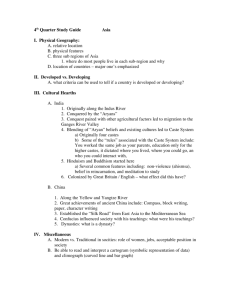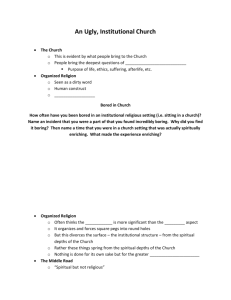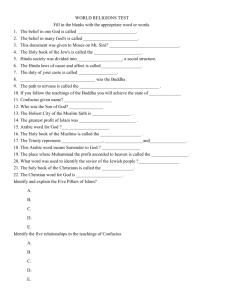Lam Rim table n char.. - Amitabha Buddhist Centre
advertisement
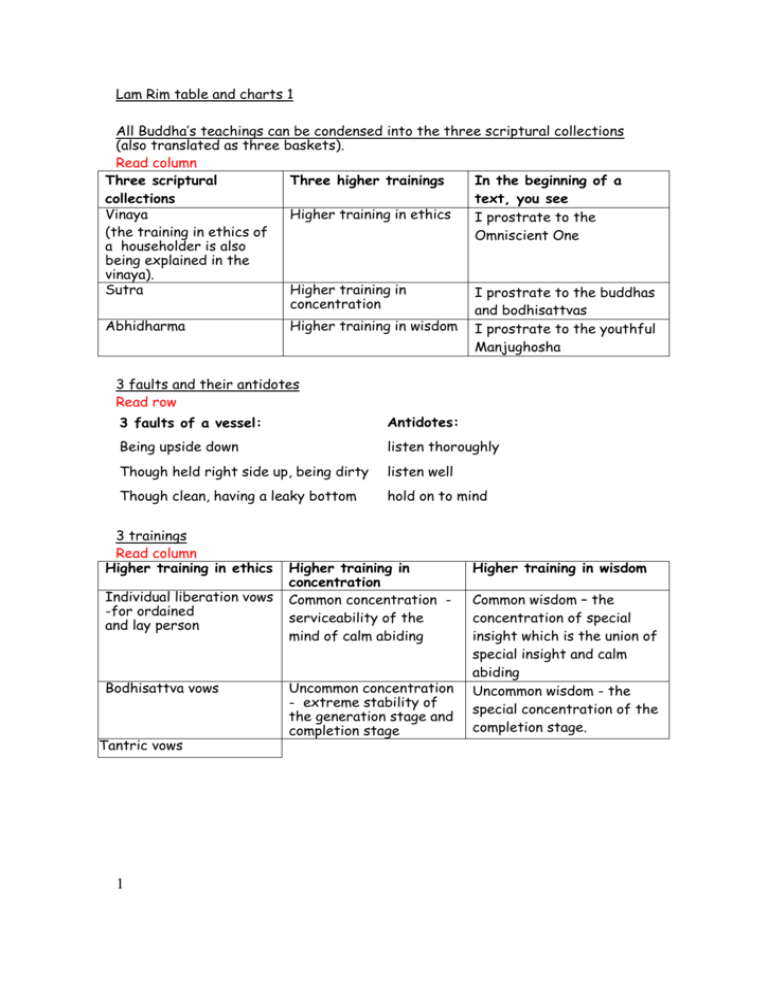
Lam Rim table and charts 1 All Buddha’s teachings can be condensed into the three scriptural collections (also translated as three baskets). Read column Three scriptural Three higher trainings In the beginning of a collections text, you see Vinaya Higher training in ethics I prostrate to the (the training in ethics of Omniscient One a householder is also being explained in the vinaya). Sutra Higher training in I prostrate to the buddhas concentration and bodhisattvas Abhidharma Higher training in wisdom I prostrate to the youthful Manjughosha 3 faults and their antidotes Read row 3 faults of a vessel: Antidotes: Being upside down listen thoroughly Though held right side up, being dirty listen well Though clean, having a leaky bottom hold on to mind 3 trainings Read column Higher training in ethics Individual liberation vows -for ordained and lay person Bodhisattva vows Tantric vows 1 Higher training in concentration Common concentration serviceability of the mind of calm abiding Uncommon concentration - extreme stability of the generation stage and completion stage Higher training in wisdom Common wisdom – the concentration of special insight which is the union of special insight and calm abiding Uncommon wisdom - the special concentration of the completion stage. Hinayana and Mahayana Read column Hinayana Mahayana Sutra The lineage of profound view ie wisdom The lineage of extensive deeds (or conduct) ie method The lineage that came from Manjushri who passed down to Nagajuna The lineage that came from Maitreya who passed down to Asanga pertaining to the practice of bodhisattvas and the training in bodhicitta and so forth 4 Buddhist tenets schools Read row 1 MWS (Middle Way School) 2 3 4 Tantra The lineage that came from Manjushri who passed down to Shantideva pertaining to the mind training or with regards to conduct and so forth CMWS (Consequence MWS) – highest school. AMWS (Autonomy MWS) MOS (Mind Only School) SS (Sutra School) GES (Great exposition School) – lowest school Mahayana path Read column Shared Mahayana path (ie common with the Hinayana path) Unshared Mahayana path This includes the teachings on refuge, karma, the general and the specific sufferings of cyclic existence, renunciation or the thought to be liberated from cyclic existence, the presentation of the Four Nobles Truths, the presentation of the twelve links of dependent arising, the presentation of the stages of the three higher trainings. This comprises the thought that is the development of the spirit of enlightenment and the deeds of training in the six perfections. 2 The teaching of the Buddha can be divided into: Read row 1 Scriptural teachings The three scriptural Those scriptures collections are the that contain the scriptural teachings information as to how or what we should put into practice. 2 The realizational Realizational teachings are the three higher teachings trainings The teachings or methods that we are supposed to put them into practice. One preserves and upholds the scriptural teachings by first learning the scriptures so one understands and holds the scriptures On the basis of one’s realization and then spread those teachings to others, this is what we mean by preserving and upholding the realizational teachings When we talk about how the teachings are free of contradiction, we mainly refer to the realizational teachings. Scriptural knowledge is knowing many texts. Realizational knowledge is engaging on proper practice. Attitudes for teacher and student Read column 5 attitudes for the teacher: Those listening to the teachings as sick persons Think of yourself as a doctor The teachings as medicine The tathagatas as excellent beings Wish that the teachings remain for a long time. 3 6 attitudes for the students: Think of yourself as a sick person. Think of the teacher as a doctor. Think of the instructor’s explications as medicine Think of earnest practice as the way to cure your disease. Think of the Tathagatas as excellent beings. Wish that the teaching will endure for a long time. Characterisers of teachers and students Read column 10 defining characteristics of the Mahayana teacher (as in Maitreya’s Ornament of the Sutras): Discipline – The Mahayana teacher must have disciplined themselves through the practice of ethics. Serene - The Mahayana teacher must have pacified his own mental distraction through the practice of concentration; therefore making his mind serene. Thoroughly pacified indicates a quality that comes from the training in wisdom. Because of having trained in wisdom, the teacher pacifies his own mental afflictions such as the three mental poisons. It means having the realization of the selflessness of persons. 3 Defining characteristics of the student (as in Aryadeva ‘s 400): Impartial Intelligent Full of endeavour (hardworking) Having good qualities surpassing those of the students The Mahayana teacher must possess qualities that exceed or surpasses those he is going to teach Energetic -The Mahayana teacher should be energetic, put effort, enthusiastic about accomplishing the welfare of others and helping others Having a wealth of scriptural knowledge means having heard and learnt extensively all the different teachings Having thorough knowledge of reality – this can mean having the realization of selflessness of phenomena; in particular having the realization of emptiness as explained by the highest Buddhist philosophical school -the Consequence Middle Way School (CMWS). Having skill in instructing the disciples means the teacher has skilled in putting across the instructions to the listeners (students) and skilled in guiding them according to their abilities The teacher should possess loving concern means possessing sincere love and concern for the disciples that are to be guided The Mahayana teacher should have abandoned dispiritedness means the teacher should not be discouraged of having to explain things over and over again because the students fail to understand In addition to the 3 qualities of a student, Candrakirti mention 2 more qualities: (4) of being focused (5) having respect for the teaching and the teacher 4 For teachers: These six qualities — being disciplined, serene, and thoroughly pacified, having good qualities that surpass those of the students, the wealth of knowledge from studying many scriptures, and thorough knowledge of reality — are the good qualities obtained for oneself. The remaining qualities — being energetic, having skill in instruction, possessing loving concern, and abandoning dispiritedness — are the good qualities for looking after others. Guru Read row Best guru have all the 10 characteristics “Middling” guru possess the three trainings, realization of suchness and a loving heart (ie 5 characteristics or qualities) At least, guru is: someone whose positive qualities exceed the faults. In particular, that teacher should emphasize the happiness of future lives more than happiness in this life. In weighing the interest of others versus one’s self interest, the teacher should emphasize the benefit of others’ welfare. It is not possible to have bodhicitta but not have renunciation. Read row Have renunciation, compassion but not great compassion, Hearers, Solitary wisdom directly realising emptiness realisers Have renunciation, great compassion, bodhicitta, wisdom Arya Bodhisattvas directly realising emptiness and Buddhas 5 3 types of faith Read row Clear faith In the context of correctly relying on the teacher in thought, the faith here is clear faith; which means that through seeing the qualities of the teacher, the mind becomes clean, clear and filled with joy Faith of conviction For example, when you think about dependent origination or cause and effect, you come to be convinced of them. Then you will develop faith. That is what we called faith of conviction Aspiring faith or wishing faith Let’s take the four noble truths. By analyzing the four noble truths correctly, you come to understand that the first two truths -True Suffering and True Origin- are the objects to be abandoned. Then you realized that True Cessation and True Path are what we must achieve. One then develops this aspiring faith. You are aspired to want to actualize the True Path and True Cessation. The faith thinking “I shall definitely obtain them” Interest Read row Uncontrived interest in this life Worldly being Interest in the future life has become paramount. Attain the joys of samsara by means for their welfare alone. Person with the small capacity Interest to get out of samsara. Strive for their own peace. Person with the medium capacity Interest to attain non-abiding nirvana (ie Buddhahood). Person with the Sincerely want to extinguish all the sufferings of others by great capacity understanding their own sufferings. 6 4 greatness of Lam rim Read row Nothing contradictory in all Buddha's teachings it is wrong for a Mahayanist not to train in the Hinayana path Every scriptural pronouncement without exception dawn on my mind as personal instruction what you listen (on Buddha teaching eg Lam Rim) and reflect, you meditate Discover what the Buddha intended by depending on Guru's instruction you easily understand what is Buddha's intention without the need to study the 84 000 teachings in its entirety Protect you from the abyss of the great error of abandoning the Buddha teaching if a Mahayanist say that he do not need to practise Hinayana teachings, he is abandoning the Buddha's teachings. Setting up representations of body, speech and mind and offerings Read row Body eg Buddha Shakyamuni eg Amitabha Buddha eg Kuan Yin Pusa Speech (Dharma Book) eg Wisdom of Perfection Sutra text eg Heart Sutra text Mind Stupa eg. electric light offering eg. 7 water bowls offerings eg. electric light offering 7 Surpassable and unsurpassable offering Read row Surpassable offerings Flowers, incense and so forth are those offerings made by worldly persons Unsurpassable The unsurpassable offerings are completely good things offerings created by those with power such as bodhisattvas e.g. bodhisattva Samantabhadra. Wish fulfilling jewels, wish granting tree and great treasure vase are unsurpassable offerings created through the power of the bodhisattvas. Generating bodhicitta -altruistic intention to achieve enlightenment for the benefits of sentient beings is an unsurpassable offering. Generating great compassion in your mind is also an unsurpassable offering. Upholding the dharma: When we talk about the dharma, there are two: scriptural teaching and realizational teaching. Upholding these two teachings become an unsurpassable offering. Transforming our root of virtues into the aspect of offering substances and then offer it, that is also considered as unsurpassable offering. 8


